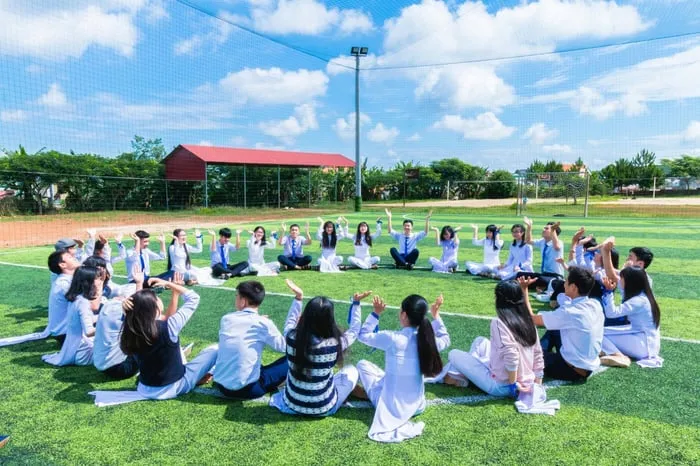How it Works
Restorative practices shift the focus from punishment to accountability, growth, and healing.
These approaches:
Restorativ helps schools implement and scale restorative approaches to reach more at-risk students—before conflicts escalate into serious issues. By identifying early warning signs and providing intervention at the right moment, schools can prevent repeated behavioral incidents, reduce long-term disciplinary costs, and improve student success. With a scalable digital platform, schools can implement restorative approaches efficiently across multiple campuses, ensuring no student is left behind.
Investing in restorative justice saves money by decreasing costly suspensions, lowering dropout rates, and reducing the need for external disciplinary interventions. More importantly, it fosters a proactive, supportive school environment where students feel heard and empowered.
More than 11 million students have attended a restorative school in the USA.
35% reduction in school arrests on average
(University of Chicago, 2019)
When implemented effectively, schools using restorative practices see real, measurable results:
Reduced out-of-school suspensions from 105 to 53, disciplinary referrals from 1,752 to 815, and detentions from 844 to 332 after implementing restorative justice (Chmelynski, 2005).
Implemented peer mediation and conferencing, leading to a drop in repeat offenders from 37 to just seven and a decline in dropout rates from 17% to 12% (Schachter, 2010)
Achieved a 53% decrease in suspensions and a 75% decrease in referrals to the principal in just one year (Schachter, 2010).
Restorative practices shift the focus from punishment to accountability, growth, and healing.
These approaches:
Studies show that implementing restorative circles leads to significant improvements in school climate and student outcomes:
Students prefer using the Circle process over traditional disciplinary measures. Preventative circles reduce conflict and encourage students to take ownership of resolving their own conflicts among themselves.
Zero-tolerance policies often lead to unnecessary suspensions and even juvenile justice involvement. Restorative justice provides an alternative, reducing school exclusions and keeping students engaged in learning and personal growth.
Beyond resolving conflicts, restorative practices help build stronger, lasting relationships among students and between students and staff.
Students learn how to handle disputes constructively rather than resorting to aggression or avoidance. Staff also gain valuable tools to guide students through resolution processes.
Restorative conversations improve understanding, prevent rumors, and get to the root of issues, creating a healthier school environment. These build a restorative school culture which is an effective way to reduce bullying.
Students participating in restorative circles often show increased maturity, better behavior, and greater confidence, leading to academic and social growth. These soft-skills build resilience and help students succeed after high school.
Restorativ helps schools implement and scale restorative approaches to reach more at-risk students—before conflicts escalate into serious issues. By identifying early warning signs and providing intervention at the right moment, schools can prevent repeated behavioral incidents, reduce long-term disciplinary costs, and improve student success. With a scalable digital platform, schools can implement restorative approaches efficiently across multiple campuses, ensuring no student is left behind.
Investing in restorative justice saves money by decreasing costly suspensions, lowering dropout rates, and reducing the need for external disciplinary interventions. More importantly, it fosters a proactive, supportive school environment where students feel heard and empowered.
Restorativ is designed for seamless integration into your school's existing processes. Features include:
Assign administrators and Circle Leaders as needed, even across multiple campuses.
Control who can create, manage, and report on cases.
Easily create, track, and assign cases, involving students, staff, and community members.
Students and staff can interact with their cases through a secure mobile app.
Automatically store all documents, communications, and transcripts for transparency and efficiency. Enables system wide tracking of impact.
Host restorative circles virtually when needed, with built-in communication tools.
Centralized hub for training materials and school-wide communications.
Optional AI-powered assistant (ROSE) suggests restorative responses in real-time.
Interactive reports keep administrators informed on case outcomes and trends.
Restorativ makes it easy to analyze and report on restorative practices to school boards, district officials, and other stakeholders. The platform tracks::
Join the growing number of institutions and organizations that are transforming their disciplinary approaches with Restorativ.co. Let’s build a school environment where accountability, growth, and community thrive.

In recent years, restorative justice (RJ) has gained significant attention as a powerful alternative to traditional punitive disciplinary measures in
Restorative Practice is a way to be, not a process to follow or a thing to do at certain times. It’s a term used to describe principles, behaviours and approaches which build and maintain healthy relationships